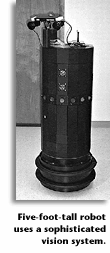


This scene wasn't played out in some Silicon Valley lab; it happened last week in Western New York at Amherst Systems, Inc., a high-tech company of about 200 employees that develops equipment that tests and evaluates aviation electronics.
 According to engineers at the company, it wouldn't have happened at
all if it were not for the intense collaboration between Amherst Systems
and a team of computer scientists at the University at Buffalo.
According to engineers at the company, it wouldn't have happened at
all if it were not for the intense collaboration between Amherst Systems
and a team of computer scientists at the University at Buffalo.
It's not an isolated incident.
At a time when companies are rethinking and often reducing their research and development operations, UB's role in providing a vital economic service to area businesses is becoming more important.
In-house research not enough today
"With today's very rapid pace of technological advance, industry can no longer remain competitive by relying solely on in-house research and development," said Dale M. Landi, vice president for research at UB.
"Commercial companies need access to institutions that offer both advanced technologies and the scientific personnel that can customize technology and specific applications. In Western New York, that place is UB."
From conducting analysis of dental adhesives to improving the design of devices for the disabled, more and more local companies are tapping UB's broad range of R&D capabilities for services that are critical to their current and future viability.
In some cases, such as Amherst Systems, the relationship helps create new jobs, while in others, such as Ivoclar, Inc., of Amherst and Enidine, Inc., of Orchard Park, it allows a company to broaden its product base.
"If we had not been doing the work with UB, we would have gotten neither the original Small Business Innovative Research contract from NASA to develop the robot nor the two subsequent contracts," said Cesar Bandera, head of the Machine Vision Department at Amherst Systems. Such grants are available only to companies working in partnership with a university.
Company plans to hire more engineers
As a result of its NASA contracts, Amherst Systems has been able to recruit a computer engineer from England's Oxford University, along with an additional four engineers who are working on the prototype robot. The company plans to hire even more engineers as the project proceeds with additional NASA funding. A prototype of the robot will be demonstrated for Johnson Space Center officials in April.
Bandera explained that NASA was seeking a sophisticated artificial-intelligence control system combined with a vision system that could accomplish real-world tasks. The goal was to develop a robot that could perform these tasks autonomously in dangerous environments, such as outside of a space shuttle or a space station.
At Amherst Systems, Bandera's group has designed a vision system that allows robots to see the way humans do, with very precise resolution in the center of the field-of-view and very wide peripheral vision at lower resolution.
That type of vision, called foveal vision, is a critical component for the NASA applications, but NASA also required an artificial intelligence component. It was an area out of Amherst's field of expertise, so Bandera calls it "serendipitous" that he attended a seminar given by a UB graduate student, Henry Hex-moor, that discussed exactly the kind of intelligence the vision system needed.
Today, the robot is controlled by an artificial intelligence technique developed by Stuart Shapiro, professor and chair of the Computer Science Department, who is an internationally recognized expert in the field, and Hexmoor, who has since earned a doctorate and is now a research assistant professor at UB.
That technique utilizes SNePS, Semantic Network Processing System, a general knowledge representation system developed by Shapiro over the past two decades.
Robot can function cognitively on several levels
The robot is technically remarkable: It relies on its sophisticated vision system more than any other robot developed to date, while also being able to function cognitively on several different levels.
"We would not have had the time to develop such a system, nor should we have," said Bandera. "Since we are a small business, we have to choose our battles wisely."
Local firms need not be making products that go into outer space to benefit from a research-and-development relationship with UB.
In fact, UB last year licensed to Enidine, Inc., a "smart" new seismic-protection technology that is literally down-to-earth.
Transfer of technology developed at the university is a critical aspect of the UB/industry partnership.
UB researchers register their technologies with the UB Office of Technology Transfer Services, whose job it is to make them available for public benefit and to place technologies or inventions with industry. Many of the matches involve companies in Western New York and contribute to economic development in the region. The office administers the commercialization of products and processes developed by UB faculty, including intellectual-property protection and licensing of inventions. Fees collected by the office benefit the university and the inventors.
The new technology licensed to Enidine-its technical name is Real-Time Structural-Parameter Modification system (RSPM)-is an energy-dissipation system based on the biomechanics of the human body. It is designed to reduce vibrations, such as those produced by earthquakes, in manmade structures. RSPM allows a structure to adjust itself in real-time in response to an earthquake.
It was developed by George C. Lee, Samuel P. Capen Professor of Engineering at UB and director of the National Center for Earthquake Engineering Research at UB.
Enidine manufactures and markets industrial shock absorbers, seismic dampers and vibration isolators with applications in robotics, materials handling, packaging, defense, aerospace and seismic systems.
In addition to seismic-mitigation products for new and existing structures, the new technology may be useful for other systems, such as those in electronics applications and offshore structures, where protection from impacts and/or vibrations is essential.
That transfer of the RSPM technology-a critical aspect of the UB/industry partnership-has resulted in a university-industry-government partnership. UB, Enidine, Moog Controls and the Office of Naval Research now are developing the new technology for military and commercial applications. Under a $6.7 million cooperative agreement, the institutions will be working together to develop the RSPM system for shock protection in naval applications and for seismic protection in civil applications.
"Universities provide industry with a greater capability to research new technologies," said Edward J. Krasnicki, president of Enidine, adding that industry allows universities to develop and commercialize basic research.
"Our partnership has allowed both of us to expand our capabilities and strive for greater achievements," he said. "The successful development of new technologies in the future will be built by partnerships, such as ours, that utilize each partner's strengths and resources."
Sometimes an industrial partnership with UB becomes so much a part of a company's R&D effort that it evolves into a formal agreement on future projects.
Companies with which UB has developed such agreements include Enidine and Praxair, which has had an ongoing R&D partnership with UB for much of the past decade.
One of the most recent such agreements is with Ivoclar, Inc., a dental products firm. It recently formalized a research-and-development agreement with UB to conduct product development, testing and clinical evaluation on a routine basis during the next five years.
"Right now, we are very aggressively pursuing new areas of product development and this agreement allows us to use UB in a consulting capacity, to rely on them for expertise we don't have in-house to evaluate and assess various materials," said George Tysowski, vice president of technology for Ivoclar.
While the firm has had such relationships with other universities across the U.S., Tysowski said the company realizes economic benefits such as low travel costs from keeping such ties close to home.
He noted that when Ivoclar sends work out-of-town, it simply receives a written report about the results.
However, when Ivoclar uses faculty and students in the UB School of Dental Medicine to evaluate products, company and university personnel work side-by-side, so Ivoclar learns the results of investigations first-hand.
"And it keeps dollars and cents here in Western New York," Tysowski added.
By testing and evaluating products for the company, UB's dental clinics also play an important role in the partnership with Ivoclar.
"The university has a huge pool of patients to draw on in trying out new products in formalized clinical trials," Tysowski added. "They're a third party, so they can provide external expertise as far as product relevance."
Sebastian Ciancio, professor and chair of the dental school's Department of Periodontology, is research coordinator of Ivoclar's partnership with UB.
Tysowski also noted that Ivoclar has benefited from its relationship with UB's South Campus Instrument Center, which services more than 60 companies. (see related story)
Another on-campus group working with a growing roster of companies is the Rehabilitation Engineering Research Center for Technology Evaluation and Transfer (RERC-TET) housed in the School of Health Related Professions.
Its aim is to find inventors who have designed promising, but untested, devices for disabled consumers and to move them from the workshop to store shelves.
The center fills the gap between inventors who may lack the appropriate resources with which to market their ideas to potential manufacturers and manufacturers who often lack information about the needs and product requirements of disabled consumers. Its commercialization arm, AZTech, Inc., finds manufacturers for products, facilitates contract negotiations and works to provide private or corporate inventors with resources necessary for product evaluation and marketing.
In the few years in which the center has been in operation, it has established formal working relationships with 22 private and corporate inventors and has been responsible for moving into or toward the marketplace a total of 10 devices.
Last June, with the assistance of AZTech, Inc., Columbus-McKinnon Corp. of Amherst introduced an inexpensive personal lift system.
According to Robert C. Dearstyne, director of sales at Columbus-McKinnon Corp., an extremely difficult challenge faced by innovative companies is the task of assembling a representative group of capable persons to provide critical feedback as part of a focus group.
"AZTech Marketing Services, an affiliate of UB, offered us a solution to this challenge," he said.
He said it organized three focus-group sessions, which were videotaped so reactions and comments could be reviewed unfiltered.
Through the focus groups, the company was guided in its effort to test price sensitivity, perceived value and product applications, as well as reactions to its product.